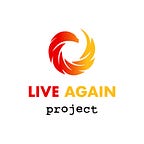A Doctor Reflects on the Importance of Taking Time to Be Human after losing her sister to cancer
Dr. Tina Hardley is a veteran Interventional Radiologist working as a senior partner in a large tertiary hospital in Los Angeles. She grew up in the “ghetto”, raised by a single mom, with her sister as her very best friend and confidant. She excelled, put herself through the best training facilities in the country including UC San Diego School of Medicine and Johns Hopkins, while raising 2 daughters on her own. Through the passing of her sister, Dr. Hardley reflects of the lesson of this Live Again Story:
“My Live Again Story has to do with my sister. She was my greatest confidant, my closest friend, and my closest family member. We did everything together from the time we were kids, latchkey kids in fact, and we spend a lot of time together without our parents around. Our dad wasn’t in our lives and our mom worked a lot and went to school. So, it was just the two of us.
We got up together. We lay down together. We went to school together. We cooked our meals. Pretty much the entire day was just us two together, and just for a few hours each day we saw our mom. The thing that touched me the most about the experience with my sister is the time that I lost her. In fact, right before that, I was too busy to spend a lot of time with her because I was working so much as a single mom but my sister interestingly enough had uterine fibroids, and she went for uterine fibroids embolization and this was about the time that the procedure had just become popular.
It was still not FDA approved and I was in residency in Hopkins and she came to DC to have her procedure done by one of the premier interventional radiologists doing embolization. Unfortunately after the procedure her fibroids continue to grow, she underwent a biopsy and was diagnosed with leiomyosarcoma. So from there, there was a long period during which time she had a multitude of surgeries and procedures, some of which were done at my own hospital by myself and my colleagues. [With] complications from surgery, no further treatment was recommended.
I at that time was a new partner with my practice and it was very busy. It was really a blossoming practice and addition to that I had two young girls of my own, so I had a lot of things on my plate, my own patients, my practice which I love and still do today, my two daughters were growing up. My sister was still functional and still waking up and doing things for herself every day, [but] she was literally dying from her incurable disease.
I got a call from her, the day before she died, and she said she broke her leg and that was odd because she was no longer working and she was at home. She wasn’t terribly mobile, she could walk but she was in a wheelchair but she was getting up from the table and she heard a crack and she called 911. I asked her to have them bring her to my facilities so that I could keep an eye on things and she underwent an x-ray and they saw the broken leg, an orthopaedic surgeon was called and they had planned to put in a rod.
At that time I spoke to the orthopedic surgeon and they thought that this was all related to osteoporosis from her poor nutrition and throwing up and things like that and, but being a radiologist addition to an intervention radiologist, I had reviewed the film and I did see that there was so as evidence of [a lytic (metastatic) lesion] which was strange because no-one had ever saw a case of leiomyosarcoma going to bone. So I talked to the orthopaedic surgeon and I told him what my findings were and he said, “No, this is osteoporosis, I am just going to put a rod in.”
And he took her to the OR, put in a rod, and she never woke up. She died the next morning. Her lungs were extremely stiff from diffuse metastatic disease. We had known that, but we did not know the dangers of surgery given that her lungs were so stiff and she couldn’t be adequately ventilated.
So the saddest thing about that is was when she was in the ER, I was down in the interventional suite doing a case. I went down to see her and she asked me, “Please come see me right before I go to sleep in the OR.” I said, “I would try.” However, I was scrubbed and before she went to sleep she was asking for me and the anesthesiologist trying to calm her, said “She is right outside.” And so my sister agreed to go ahead and go to sleep and actually I wasn’t outside. I was down doing a case and I truly regret not being by her side because that was, you know, the last time that I saw her alive.
It told me then that despite my career and the things that I have on my plate, one of the most important things we have to do as human beings is to be human.
We have to make time for our families, make time for people in need, make time for people with cancer particularly when no other options are available to them and they are reaching out to try to hang on for as long as they can.”
